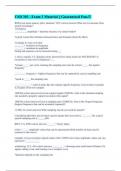CSD 303 - Exam 3 Material || Guaranteed Pass!!!
RMS (root mean square), jitter, shimmer, VOT correct answers What can we measure from speech recordings?
1) loudness
__________ amplitude = intensity measure of a sound window
2) pitch (vocal fold vibration characteristics) and formants (from the filter)
3) change in voice over time
_______ = variations in frequency
_______ = variations in amplitude
timing and sequence can be measured using ___
2, twice, nyquist, 1/2, aliasing correct answers How many points are NECESSARY to reconstruct a sine wave's frequency? ___
*at least _____ per cycle, meaning the sampling rate must be at least _____ the signal's frequency
_________ frequency = highest frequency that can be captured by a given sampling rate
*equal to _____ the sampling rate
_____________ = when it looks like the original signal's frequency is lower than it actually is, because of too few samples
1600 Hz correct answers Given an original signal of 800 Hz, what is the minimal sampling rate needed to properly capture/reconstruct this signal?
1000 Hz correct answers Given a sampling rate of 2000 Hz, what is the Nyquist frequency (highest frequency that can be accurately captured)?
11,000, 22 correct answers What sampling rate do you need for speech?
Considering that there are not many speech signals that occur above ________ Hz, a good speech sampling rate is ______kHz
BITS, 2^n, 4096 correct answers ______ = binary digits
n bits = _____ amplitude values that can be represented (think number of steps used to construct a sine wave)
example: if you reconstruct speech audio with 12 BITS, how many amplitude values can you represent? ____________
windowing, 23.2, 441 correct answers _________ = choosing some small interval/frame of a signal, cutting it out, and treating it as a complex wave
*duration depends on the sampling rate ex 1: if a window contains 512 samples, and the sampling rate is 22,050 Hz, how long is the window?
_________ ms
ex 2: If you want your window to be 20 ms long, and the sampling rate = 22,050 Hz, how many samples will be in the window?
_______ samples
time, accuracy, shorter, longer correct answers choosing window length creates a _____-
______ tradeoff!
*________ windows provide better resolution, but there's less data to estimate values you're interested in *_______ windows provide more data to improve estimates, but worse time resolution
step, step, shape, hamming correct answers window _____ = how much we slide a window over (think: how often are we making a measurement?)
*smaller _____ size creates more overlap between windows, and better time resolution
window _____ = how much we weight the beginning and end of the window
*altered to avoid clicks between multiple copied samples/speech segments lined up in a row
_______ window = common window used in the real world, where the signal gradually moves from zero (left edge) to maximum (center), and back to zero (right edge)
RMS, 6.16, smoother, sudden correct answers ______ is tracked over time to measure intensity of a signal
example: find the RMS of the following samples -2, 5, -8, 9, -4
*as window size increases, the RMS amplitude becomes _________, but temporal accuracy is reduced (we lose the ability to track ____ changes in intensity)
autocorrelation, estimated pitch period correct answers __________ = picking some interval of a speech signal, making a copy of it and then:
1) shifting the copy over by 1 sample, to see how well it correlates with the original wave
2) shifting it by 2 samples, and checking correlation
3) shifting it by 3 samples
4) etc.
*maximum correlation is always at lag 0 (when the signals match up perfectly), but we want to know which lag has the next best correlation
*this is called the ________________
doubling, double, halving correct answers potential problems with autocorrelation:
- pitch _____ = when one cycle of the waveform has two halves that look roughly the same, and the longest lag is determined to be less than the full pitch period




